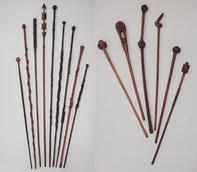Most southern African communities used a number of different terms to describe the sticks, staffs and knobkerries they used for defensive and other purposes.

Among Xhosa-speaking groups, for example, knobkerries with large knobs for throwing at game (ibhunguza) were distinguished from smaller sticks with oblong heads, although the latter were also used for throwing (umgweba). Tsonga-speakers from present-day Mozambique also differentiated between heavy clubs (sing. nhonga) and other knobkerries (sing. gungwe).
A knobkerrie made from the root of a tree was known among Zulu-speakers as an isagila, while the sticks carried by an ordinary homestead head were distinguished from those carried by chiefs. To this day, men living in some rural areas still own sticks of various kinds, and Sotho, Ndebele and Xhosa initiates continue to receive staffs in acknowledgement of their transition to adult status.
Sticks are also used in fighting stick competitions, while dance staffs continue to feature prominently on festive occasions such as weddings, where they are carried along with small dance shields, which can be tapped like a drum for periodic emphasis. As late as the 1930s sticks were carried during buffalo hunts organised by chiefs in the present-day KwaZulu-Natal region.
Because buffalo were regarded as symbols of male strength and virility, Zulu-speakers sometimes still evoke the idea of a man as being like a buffalo (inyathi). This idea of manhood is reflected above all in the sticks men wield while dancing at weddings and on other occasions.
 The motifs on this short, but elaborately carved dance staff are unusual partly because the decorative detailing is so robust, but also beca...
The motifs on this short, but elaborately carved dance staff are unusual partly because the decorative detailing is so robust, but also beca... In the outlying rural areas of KwaZulu-Natal men are not allowed to take their sticks into the court houses of chiefs for fear that they mig...
In the outlying rural areas of KwaZulu-Natal men are not allowed to take their sticks into the court houses of chiefs for fear that they mig... Exceptionally large, heavy knobkerries like the one at the centre of this spread were sometimes used to execute people at the courts of the ...
Exceptionally large, heavy knobkerries like the one at the centre of this spread were sometimes used to execute people at the courts of the ... Many, but by no means all knobkerries and other sticks were embellished through the addition of strips of imported brass and copper wire wov...
Many, but by no means all knobkerries and other sticks were embellished through the addition of strips of imported brass and copper wire wov... In the nineteenth century, rhino horn staffs were regarded as prestige items among communities from present-day Botswana, Lesotho and South ...
In the nineteenth century, rhino horn staffs were regarded as prestige items among communities from present-day Botswana, Lesotho and South ... Tsonga carvers from southern and central Mozambique sometimes carved staff that doubled up as headrests. Producing items like these required...
Tsonga carvers from southern and central Mozambique sometimes carved staff that doubled up as headrests. Producing items like these required... The patrons of skilled carvers valued inventive variations in the treatment of knobs and other details, and were probably prepared to pay mo...
The patrons of skilled carvers valued inventive variations in the treatment of knobs and other details, and were probably prepared to pay mo...